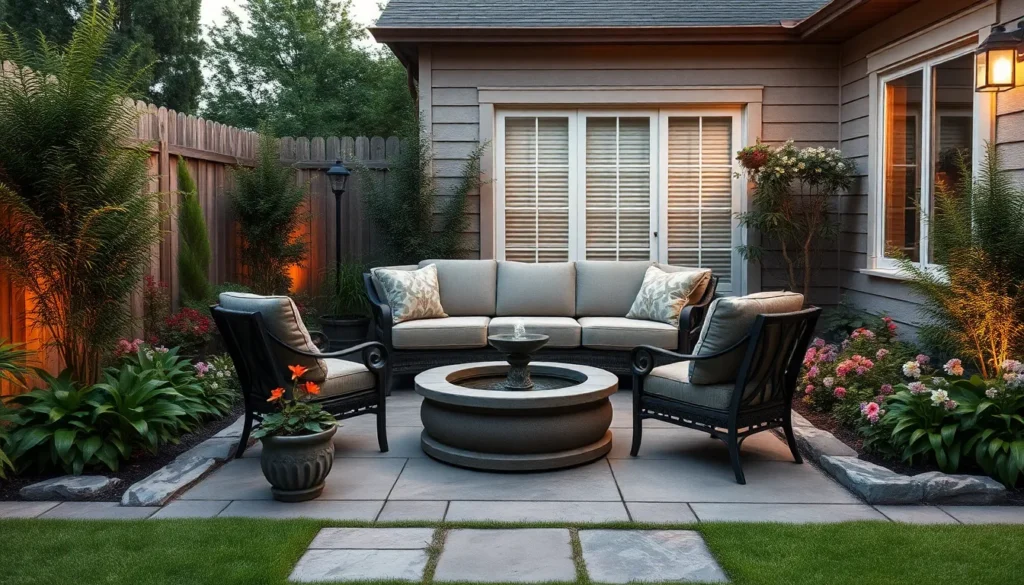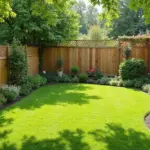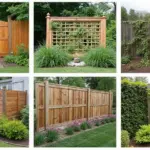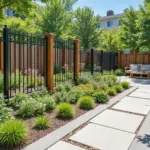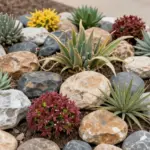Transforming your backyard patio into a stunning outdoor retreat doesn’t have to expensive or require professional expertise. We’ve discovered that the right landscaping ideas can turn even the most ordinary concrete slab into an inviting space where you’ll love spending time with family and friends.
Whether you’re working with a small urban patio or a sprawling backyard space, strategic landscaping choices make all the difference. From lush container gardens and vertical plant walls to decorative borders and cozy seating areas, there are countless ways to enhance your patio’s appeal and functionality.
We’ll share proven landscaping techniques that maximize your outdoor space while creating the perfect balance of beauty and practicality. These ideas work for any budget and skill level, helping you create an outdoor oasis that increases your home’s value and becomes your favorite gathering spot year-round.
Create a Cohesive Design Theme for Your Backyard Patio Space
Building on the strategic landscaping techniques we’ve covered, establishing a unified design theme transforms your patio from a collection of elements into a polished outdoor sanctuary. We’ll guide you through selecting and implementing a cohesive style that ties all your landscaping choices together seamlessly.
Choose Between Modern Minimalist or Rustic Natural Styles
Modern minimalist patios emphasize clean lines, geometric shapes, and carefully curated plant selections that create sophisticated outdoor spaces. Sleek concrete planters house structural plants like ornamental grasses, agave, and boxwood hedges that provide year-round interest without overwhelming the space. Contemporary furniture pieces feature neutral colors such as charcoal gray, white, or black that complement the streamlined aesthetic.
Rustic natural themes celebrate organic textures, weathered materials, and abundant plantings that create cozy, lived-in atmospheres. Reclaimed wood planters, stone pathways, and wrought iron furniture establish the foundation for this welcoming style. Native wildflowers, climbing vines, and herb gardens flourish in this setting while maintaining the casual, cottage-inspired feel.
We recommend choosing your style based on your home’s architecture and personal preferences rather than following temporary trends. Colonial or craftsman homes typically pair beautifully with rustic elements, while contemporary houses benefit from minimalist approaches that echo their architectural lines.
Coordinate Colors and Materials Throughout the Space
Material consistency creates visual harmony across your entire patio industry through repeated elements that guide the eye naturally. Stone, wood, metal, and fabric selections should appear in multiple locations throughout the space to establish rhythm and balance.
| Material Type | Modern Minimalist | Rustic Natural |
|---|---|---|
| Hardscaping | Concrete, steel, composite | Natural stone, reclaimed wood, brick |
| Planters | Fiberglass, ceramic, metal | Terra cotta, wood, stone |
| Furniture | Aluminum, teak, wicker | Wrought iron, cedar, vintage pieces |
| Accents | Glass, stainless steel | Copper, galvanized metal, rope |
Color palettes work best when limited to three or four complementary shades that appear consistently in plants, furniture, and decorative elements. Neutral bases like beige, gray, or white allow colorful flowers and foliage to become the stars while maintaining sophisticated appeal. Accent colors through cushions, planters, and seasonal flowers add personality without overwhelming the overall design.
Plant selections should reinforce your chosen color scheme through foliage tones, bloom colors, and seasonal interest. Silvery herbs, deep green evergreens, and burgundy ornamental grasses create rich palettes that evolve throughout the growing season.
Establish a Focal Point That Draws the Eye
Structural focal points anchor your patio design and provide visual destinations that organize the surrounding industry elements. Water features like fountains or small ponds create soothing sounds while attracting birds and beneficial insects to your outdoor space. Fire pits or fireplaces extend the usable season while providing gathering spots for evening entertainment.
Plant-based centerpieces offer ever-changing focal points that change with the seasons and provide ongoing interest throughout the year. Specimen trees such as Japanese maples, flowering dogwoods, or ornamental fruit trees create vertical interest and natural shade. Large container arrangements featuring dramatic plants like elephant ears, ornamental grasses, or sculptural succulents command attention without requiring permanent installation.
Architectural elements including pergolas, arbors, or decorative screens define spaces while adding height and structure to flat patio areas. These features support climbing plants, provide shade, and create intimate seating areas within larger outdoor spaces. Lighting integrated into these structures extends their visual impact into evening hours while improving safety and ambiance.
Position your chosen focal point where it’s visible from multiple angles, including views from inside your home through windows and doors. This strategic placement ensures your investment enhances both outdoor living and indoor enjoyment of your beautifully landscaped patio space.
Define Patio Boundaries With Strategic Hardscaping Elements
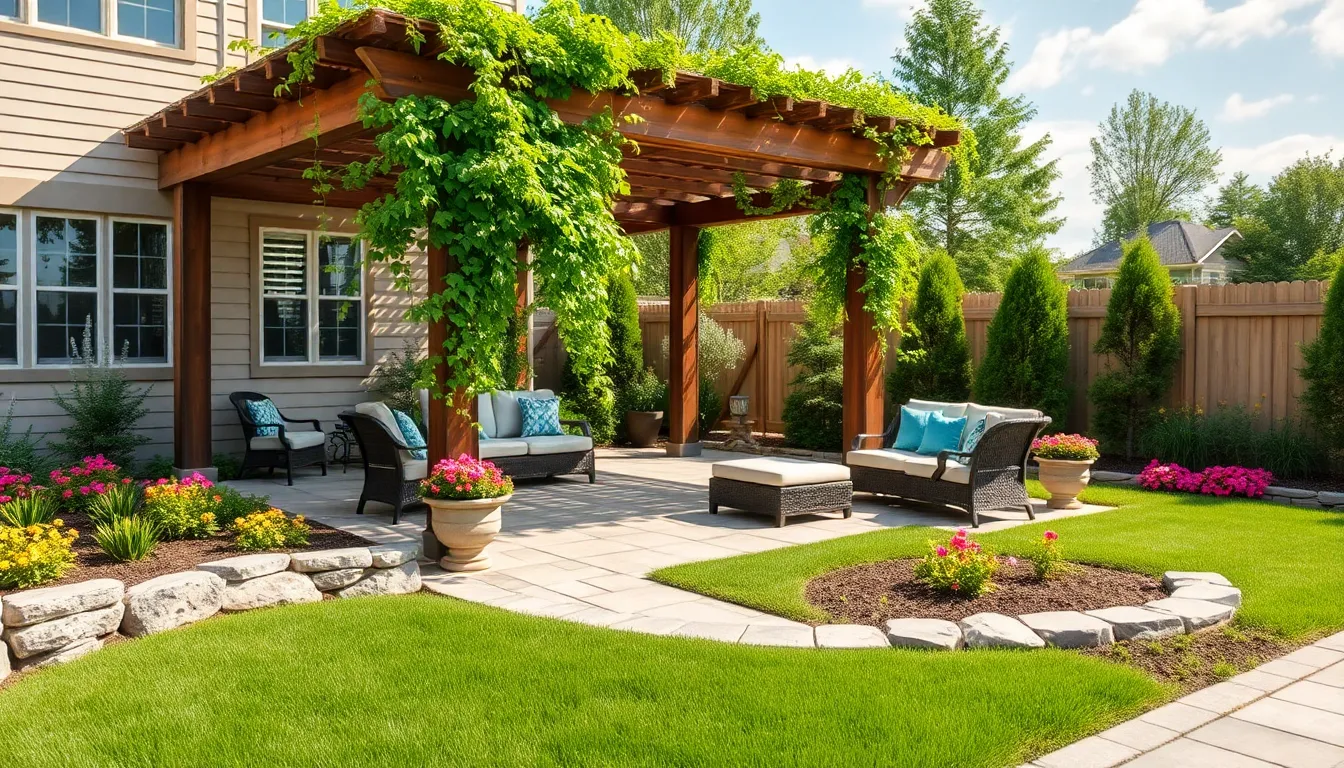
Creating distinct boundaries transforms your patio from a simple outdoor space into a well-defined outdoor room. Strategic hardscaping elements provide structure while seamlessly integrating with your chosen design theme.
Install Decorative Stone or Brick Borders
Install Decorative Stone or Brick Borders to establish clean, professional-looking edges around your patio perimeter. These durable materials create an attractive visual separation between your patio and surrounding lawn or garden areas. Stone borders work exceptionally well with rustic natural themes, while brick complements both modern and traditional design styles.
We recommend using these borders as low edging elements to contain gravel or mulch, preventing grass and plants from encroaching onto your patio surface. Position the borders at ground level or slightly raised to create subtle definition without blocking sightlines. Natural stone options like fieldstone or flagstone offer organic appeal, while manufactured brick provides consistent sizing and color matching.
Border installation requires minimal excavation and can be completed as a weekend DIY project. Choose materials that complement your existing patio surface for cohesive visual flow throughout the space.
Build Retaining Walls for Multi-Level Interest
Build retaining walls to manage elevation changes while adding important architectural interest to your patio industry. These functional structures create distinct levels that enhance both the visual appeal and usability of your outdoor space. Retaining walls serve multiple purposes beyond boundary definition, functioning as built-in seating areas or raised planter beds.
Natural stone and brick materials work best for retaining walls, as they complement most patio surfaces and provide long-lasting durability. We suggest incorporating these walls into your overall design by using consistent materials throughout your hardscape elements. Multi-level terraces created with retaining walls add depth and dimension to flat backyard spaces.
Consider the height and placement carefully to ensure proper drainage and structural integrity. Walls under three feet typically don’t require professional engineering, making them accessible for ambitious DIY projects.
Add Pergolas or Arbors for Vertical Structure
Add pergolas or arbors to introduce essential vertical elements that define your patio boundaries without creating closed-off spaces. These structures provide partial shade while maintaining the open feel that makes patios so appealing. Pergolas create natural overhead boundaries that anchor your patio within the larger backyard environment.
We recommend positioning these vertical structures to support climbing plants or vines, which soften the hardscape materials and integrate living greenery into your design. Popular climbing options include clematis, jasmine, or grape vines that provide seasonal interest and natural screening. The combination of structural elements and organic growth creates ever-changing boundaries that change throughout the seasons.
Pergolas work particularly well as transition elements between different patio zones, such as dining and lounging areas. Choose materials that coordinate with your other hardscape elements to maintain design consistency throughout your outdoor space.
Incorporate Lush Plant Beds Around Your Patio Perimeter
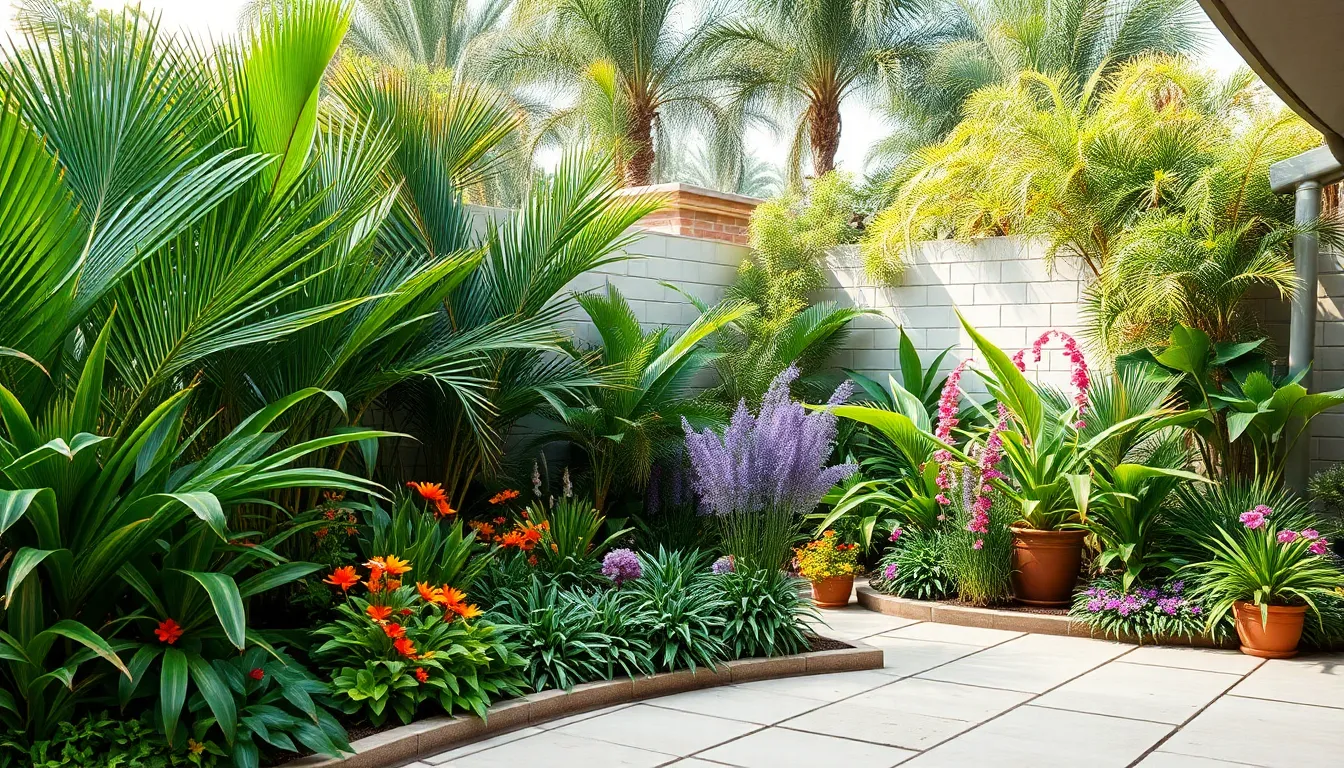
Creating vibrant plant borders around your patio transforms the space into a natural sanctuary that seamlessly blends hardscape with garden elements. We recommend surrounding your patio with a mix of tropical foliage and palms to achieve that rainforest-inspired atmosphere that provides both shade and visual appeal.
Select Low-Maintenance Perennials for Year-Round Appeal
Choosing perennials that require minimal care ensures your patio remains attractive throughout every season without constant upkeep. We’ve found that low-maintenance selections like purple coneflowers, black-eyed Susans, and ornamental grasses provide continual greenery and seasonal blooms that withstand various climate conditions.
Establishing a foundation of hardy perennials reduces your gardening time significantly. Consider plants like daylilies, hostas, and sedums that return year after year with minimal intervention. These selections keep your space looking fresh and inviting regardless of season while requiring only occasional watering and annual pruning.
Incorporating evergreen perennials maintains visual interest during winter months. We suggest adding plants like coral bells, bergenia, and hellebores that provide structure and color when deciduous plants go dormant.
Layer Plants by Height for Visual Depth
Arranging plants by height creates stunning visual depth that prevents your patio industry from appearing flat. We recommend placing tall shrubs like hydrangeas or butterfly bushes at the back, mid-height perennials such as catmint or salvia in the middle, and ground covers like creeping phlox or ajuga at the front.
Building layers provides natural habitats for beneficial insects while improving privacy around seating areas. This technique makes your space feel more immersive and creates multiple viewing levels that draw the eye through the industry. Strategic placement of taller plants behind lower ones ensures each specimen receives adequate sunlight.
Varying plant textures within each layer adds sophisticated visual interest. We suggest combining fine-textured grasses with broad-leafed hostas and spiky plants like yucca or iris to create ever-changing contrast throughout your layered design.
Choose Native Species That Thrive in Your Climate
Using native plants adapted to your local environment is essential for sustainable patio landscaping. We’ve observed that native species typically require 50% less water than non-native alternatives and need minimal fertilizer or pest protection, making them ideal for long-term success.
Supporting local wildlife and pollinators contributes to your garden’s ecological balance. Native plants provide essential food sources for butterflies, bees, and birds while creating a thriving network around your patio. Research your region’s native plant society recommendations to identify species that flourish in your exact climate zone.
Matching plant choices to your environment ensures year-round vigor with reduced maintenance effort. We recommend consulting your local extension office or native plant nursery to select species that naturally thrive in your soil type, rainfall patterns, and temperature ranges.
Install Water Features to Create a Tranquil Atmosphere

Water features transform backyard patios into peaceful retreats through their soothing sounds and visual appeal. Adding these elements creates natural background noise that masks unwanted sounds while encouraging outdoor relaxation.
Add a Small Fountain as a Centerpiece
Small fountains create excellent focal points that anchor your patio design. Freestanding options like tiered models work beautifully in open spaces, while wall mounted versions save valuable floor space in compact areas. Classic designs complement traditional homes, whereas modern geometric styles enhance contemporary architecture.
Water flowing from fountains produces peaceful background noise that drowns out traffic and neighborhood sounds. This constant gentle sound encourages longer outdoor enjoyment and creates an inviting atmosphere for guests. Positioning your fountain where it’s visible from indoor spaces extends the tranquil feeling throughout your home.
Build a Pond or Water Garden Along the Edge
Ponds bring natural biodiversity and organic beauty to your patio perimeter. Water gardens positioned near seating areas create visual connections between green spaces and entertainment zones, making your entire backyard feel more unified. Adding lily pads and aquatic plants helps oxygenate the water while providing stunning visual interest throughout the seasons.
Strategic placement along patio edges maximizes impact without sacrificing usable space. Aquatic plants naturally filter and clean the water, reducing maintenance requirements while improving the network. This positioning allows you to enjoy the water feature from multiple angles while creating a seamless transition between hardscape and industry elements.
Consider a Bubbling Rock Feature for Subtle Sound
Bubbling rocks combine natural stone elements with gentle water flow for understated elegance. Large boulders paired with river rocks create interesting flow patterns that add texture and movement to your industry design. These features work exceptionally well in pathways or garden borders where they promote a soothing outdoor ambiance.
Natural stone elements blend seamlessly with existing landscaping while providing subtle calming sounds. Water gently flows over and around the rocks, creating varied acoustic experiences as it moves through different stone textures. Positioning these features near walkways or seating areas maximizes their sensory impact without overwhelming the space.
Design Functional Outdoor Living Zones Within Your Landscape
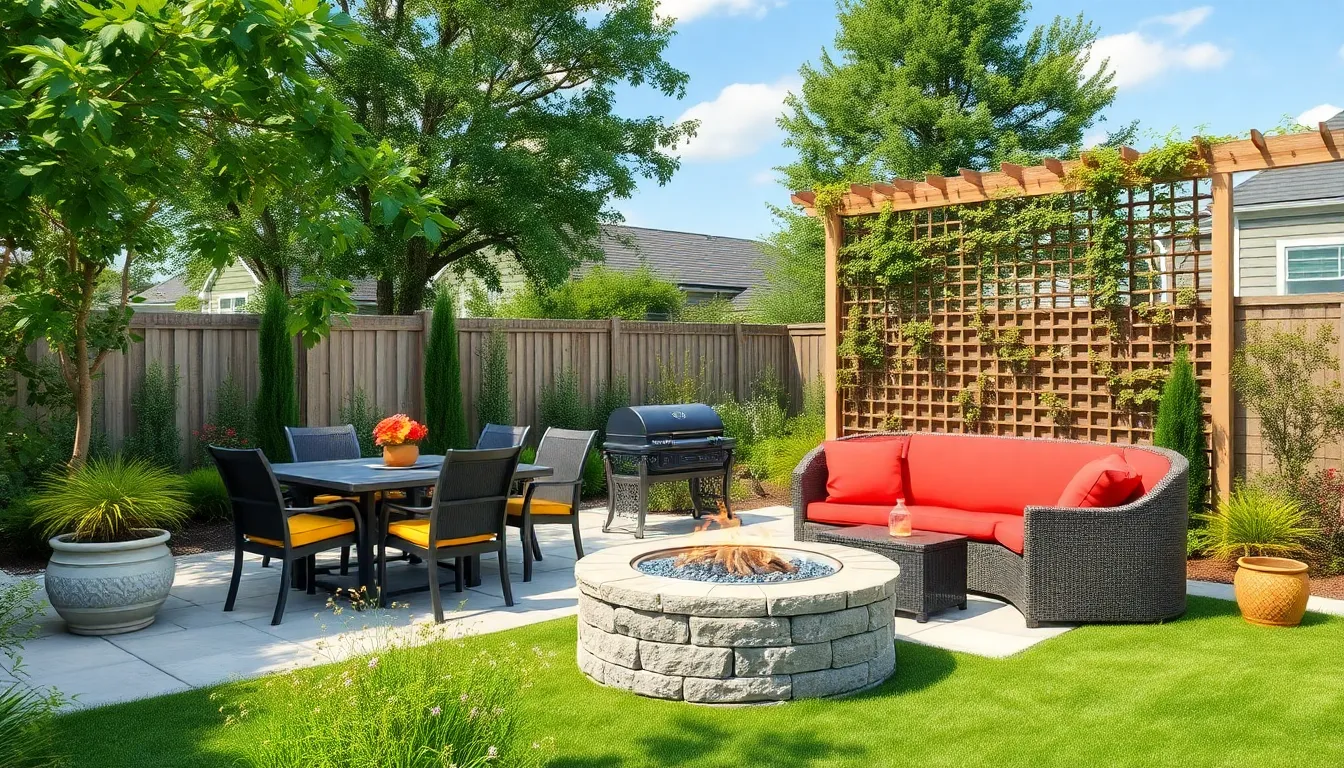
Creating distinct outdoor living zones transforms your backyard patio into a highly functional space that accommodates various activities. Strategic placement of landscaping elements like plants, planters, and pergolas helps visually anchor and define each area within your patio space.
Create a Dining Area With Weather-Resistant Furniture
Selecting weather-resistant furniture ensures your outdoor dining zone remains durable against the elements year-round. Position your dining set on stable surfaces like stone, wood decking, or pebble gravel, which provides an affordable and forgiving base for patios. Surround the dining space with greenery in both containers and planted beds to add natural shade and create an inviting ambiance for comfortable outdoor meals.
Weather-resistant materials like teak, aluminum, and all-weather wicker maintain their appearance and functionality through seasonal changes. Incorporate symmetry and large plants around your dining area to create contextual harmony between the seating space and the rest of your garden. Stone or pebble gravel surfaces offer excellent drainage while providing visual texture that complements your surrounding industry.
Establish a Fire Pit Seating Circle
Fire pits create natural gathering spots that are ideal for socializing and extending your outdoor season. Arrange seating in a circular pattern around the fire pit to foster conversation and ensure everyone benefits from the warmth. Statement focal points like stylish fire pits or colorful cushions on patio furniture enhance the inviting atmosphere of this zone.
Surrounding plants or pergolas provide privacy and enclosure for your fire pit area while maintaining an open, welcoming feel. Consider incorporating weather-resistant seating options that can withstand outdoor conditions while providing comfort during extended gatherings. Position the fire pit zone away from overhanging branches and ensure proper ventilation for safety and optimal enjoyment.
Set Up a Quiet Reading Nook With Privacy Screening
Designing separate cozy corners for quiet reading creates peaceful retreats within your backyard patio industry. Vertical gardens, privacy screens, or climbing vines on pergola structures effectively separate these intimate spaces from more active zones. Vertical gardening maximizes space in smaller backyards while adding a lush, green backdrop that enhances tranquility.
Privacy screening can be enhanced with trellises or dense plantings to create secluded areas free from visual distractions. Climbing plants on pergolas provide natural shade and seasonal interest while maintaining the cozy atmosphere essential for reading nooks. Consider incorporating comfortable, weather-resistant seating that encourages relaxation and positions your reading area to take advantage of natural light during different times of day.
Enhance Evening Ambiance With Strategic Lighting Solutions
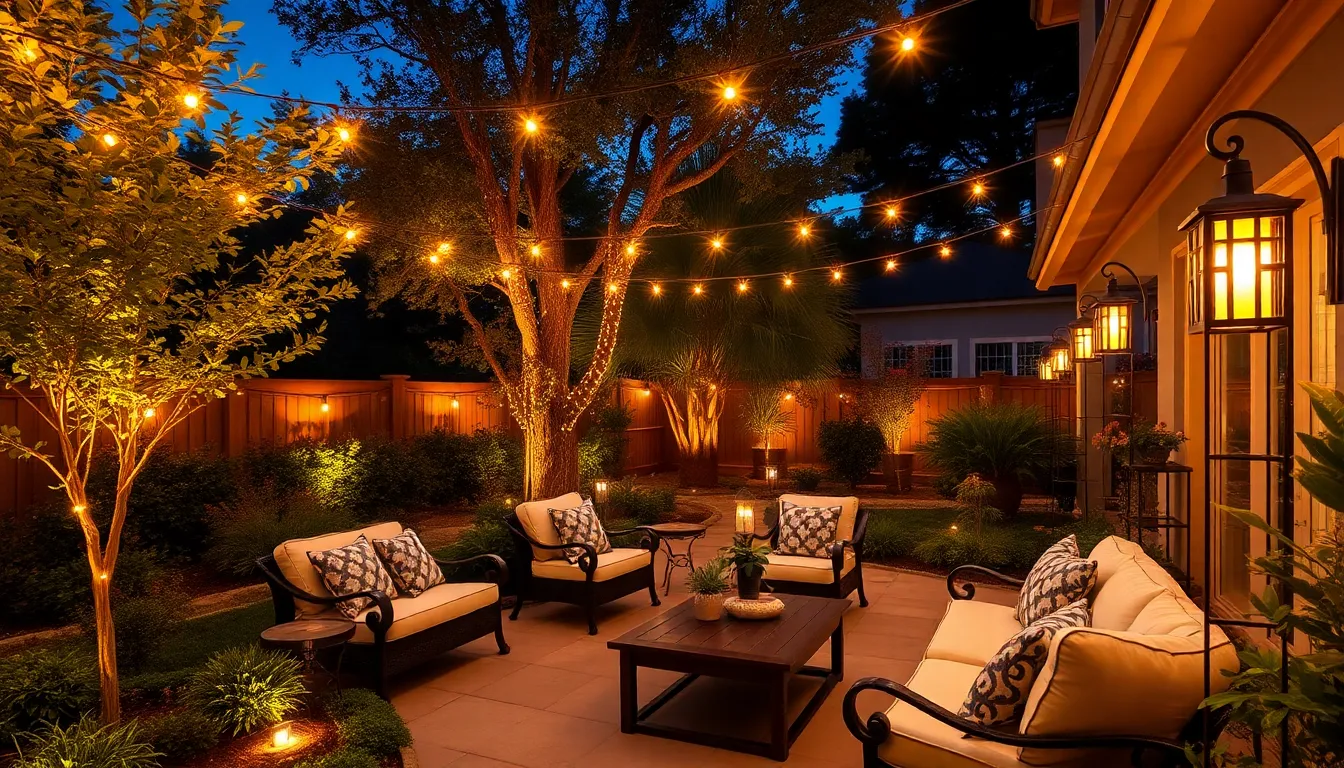
Transforming your patio into an enchanting evening retreat requires thoughtful lighting strategies that extend usability well into the night. Strategic illumination not only enhances safety but creates the perfect atmosphere for dining, entertaining, or quiet relaxation under the stars.
Install Solar Path Lights Along Walkways
Solar path lights offer an energy-efficient solution for illuminating garden paths and walkways throughout your patio industry. These eco-friendly fixtures provide soft, welcoming illumination that guides guests safely while defining clear boundaries between different areas of your outdoor space. Position them at regular intervals along walkways, around plant beds, and near seating areas to create a cohesive lighting network that enhances your patio’s inviting atmosphere.
Installation requires no electrical work since solar lights charge during daylight hours and automatically illuminate at dusk. Choose fixtures with LED bulbs for longer lifespan and brighter output, ensuring your pathways remain well-lit throughout the evening hours. Strategic placement along curved garden borders creates visual flow while highlighting your carefully planned landscaping features.
Hang String Lights or Lanterns Overhead
String lights create magical overhead illumination that instantly transforms any patio into a cozy outdoor room. Drape them across pergolas, arbors, or suspend them between trees to establish an intimate canopy of light above your seating and dining areas. Clear bulbs produce a warm, twinkling effect that adds romance and whimsy to evening gatherings.
Glass lanterns offer another charming overhead lighting option that provides rustic appeal and visual interest. Vary the sizes and hang them at different heights to create ever-changing patterns that catch the eye and enhance your patio’s architectural features. Criss-cross patterns with string lights add depth and visual complexity while ensuring even light distribution across your entire outdoor space.
Add Spotlights to Highlight Key Industry Features
Spotlights positioned at the base of trees, architectural elements, and prominent plant displays create dramatic uplighting effects that showcase your patio’s best features. This technique transforms ordinary industry elements into stunning focal points that draw attention and add sophisticated depth to your evening ambiance. Target large plants, textured walls, water features, or sculptural elements to create layers of visual interest.
LED spotlights offer the most versatility with adjustable beam angles and energy-efficient operation that keeps electricity costs minimal. Position them to cast light upward through tree canopies or across stone walls for dramatic shadow play that changes throughout the evening. Strategic spotlight placement also enhances security by eliminating dark corners while maintaining the aesthetic appeal of your carefully designed patio industry.
Additional ambient lighting options include mason jar lights for warm, mellow illumination and pendant lights over dining areas for elegant meal settings. Recessed LED deck lights and strip lighting under railings provide subtle, sophisticated accents that complement your primary lighting scheme without overwhelming the space.
Maximize Privacy With Natural and Structural Barriers
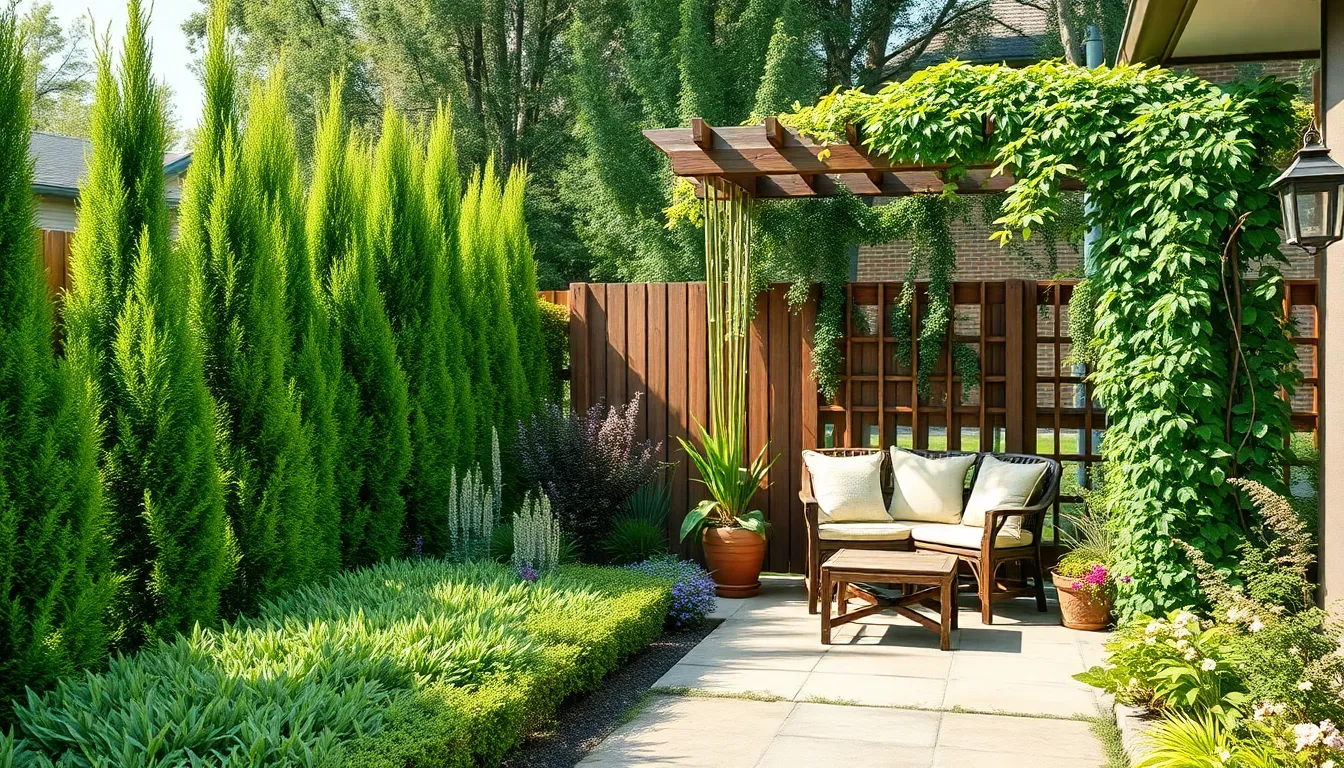
Creating a private patio retreat involves combining living elements with structural features to shield your space from prying eyes. We’ve found that the most effective privacy answers balance functionality with natural beauty.
Plant Tall Shrubs or Bamboo for Living Screens
Ornamental grasses like Panicum and Miscanthus create natural privacy screens that filter light while blocking sightlines from neighboring properties. These living barriers allow air circulation and maintain an open feel rather than creating an impenetrable wall effect.
Bamboo establishes dense, fast-growing screens that can reach impressive heights within just a few growing seasons. We recommend clumping varieties to prevent aggressive spreading into unwanted areas.
Flowering shrubs such as redbuds and Japanese maples offer seasonal interest while providing year-round privacy structure. These selections add visual appeal with colorful blooms or striking foliage that changes throughout the seasons.
Olive trees work exceptionally well in Mediterranean-style landscapes, creating sophisticated privacy screens with their silvery-green leaves and sculptural branching patterns. Their evergreen nature ensures consistent coverage throughout the year.
Install Decorative Fencing or Trellises
Wooden fencing combined with climbing plants creates attractive privacy barriers that soften harsh structural lines. Ivy and other climbing vines naturally integrate with fence materials to produce living walls that feel organic rather than imposing.
Trellises paired with flowering vines add vertical interest while creating cozy, intimate spaces around seating areas. These structures support plant growth while immediately establishing privacy boundaries.
Taller fence installations or wall combinations provide enhanced privacy levels for patios situated close to neighboring properties. We’ve found that mixing materials like wood with stone creates visually appealing barriers that complement various architectural styles.
Decorative screens with geometric patterns allow light penetration while maintaining privacy, creating interesting shadow play throughout different times of day.
Use Large Planters as Moveable Privacy Answers
Container gardens with tall plants offer flexible privacy options that adapt to changing needs and seasonal preferences. These portable answers work particularly well for renters or anyone wanting adjustable privacy arrangements.
Large planters filled with dense foliage plants can be strategically positioned around seating areas to create intimate conversation zones. Moving these containers allows you to modify privacy levels for different occasions or activities.
Wheeled planter boxes make repositioning heavy containers manageable while maintaining design flexibility throughout the growing season. These answers let you experiment with different layouts until you find the perfect privacy configuration.
Tall grasses and architectural plants in oversized containers serve dual purposes as both privacy screens and striking focal points that enhance your patio’s overall design aesthetic.
Add Seasonal Interest With Container Gardens and Planters
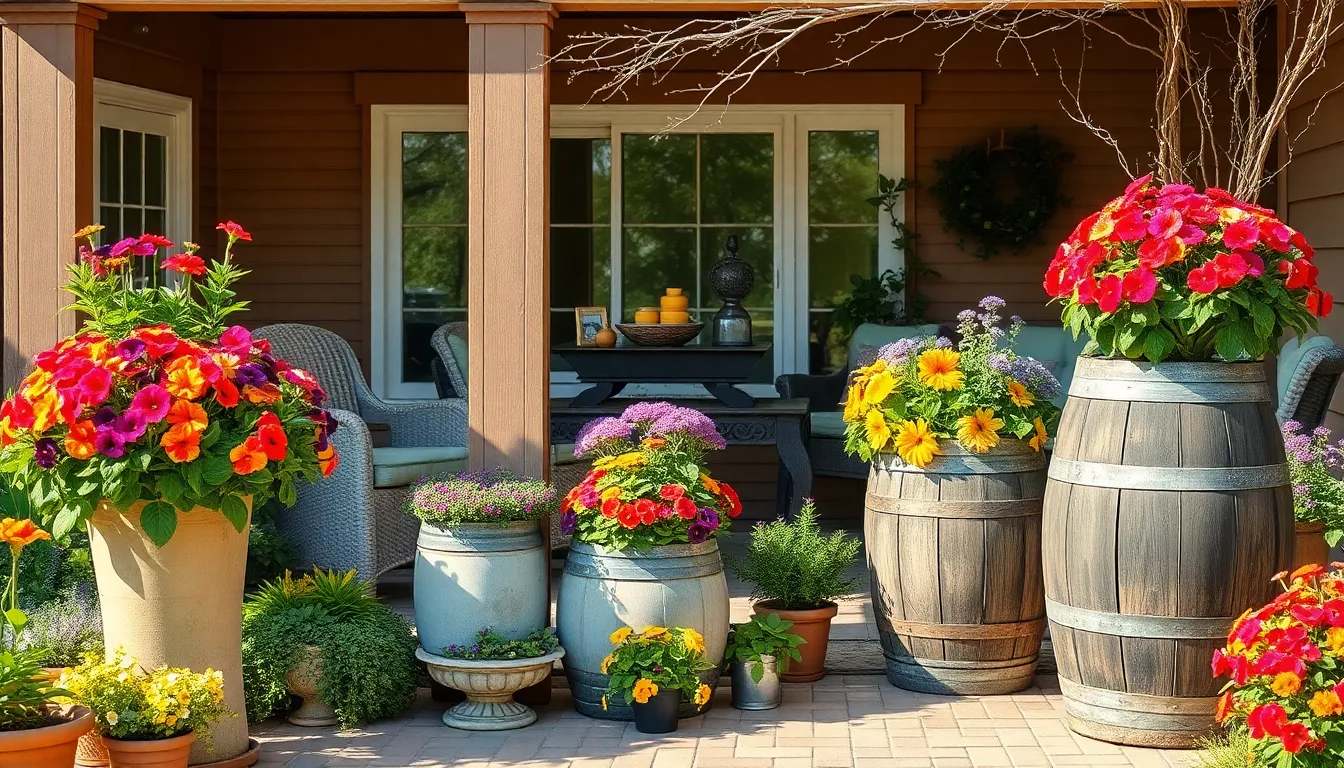
Container gardening brings flexible vibrancy to your patio landscaping while allowing you to refresh your outdoor space throughout the year. We recommend combining durable “keeper” plants like evergreens with seasonal flowers that can be rotated regularly for continuous visual appeal.
Choose Oversized Pots for Maximum Visual Impact
Large planters create dramatic focal points that transform ordinary patios into stunning outdoor retreats. We suggest selecting oversized containers that provide ample space for diverse plant combinations to flourish and develop their full potential. Grouping different shapes and colors of large pots creates eye-catching displays that make your landscaping feel lush and intentional.
Rustic vintage-style barrels work exceptionally well for bigger plants with deeper root systems like small trees or large shrubs. These containers add authentic charm while supporting substantial plant growth that smaller pots simply can’t accommodate. Bold statement pieces like oversized ceramic urns can anchor your entire patio design while providing enough soil volume for spectacular plant arrangements.
Rotate Seasonal Flowers and Plants Throughout the Year
Changing plant varieties with each season keeps your patio ever-changing and reflects the natural rhythm of the year. Spring arrangements benefit from mixing bulbs like daffodils with warm-hued annuals such as calibrachoa or sweet alyssum for fresh, welcoming displays. Summer containers can showcase heat-loving plants like petunias and marigolds that thrive in warmer temperatures.
Autumn brings opportunities to incorporate bold oranges, yellows, and whites using plants like pansies and violas that tolerate cooler weather. Winter arrangements can feature evergreen plants paired with seasonal elements like decorative branches or winter-blooming plants depending on your climate zone. This rotating system ensures your patio reflects each season with relevant colors and fragrances that enhance your outdoor experience.
Group Containers in Odd Numbers for Natural Arrangement
Arranging pots in groups of three, five, or seven creates more natural and aesthetically pleasing compositions than even-numbered groupings. This technique mimics nature’s informal patterns and allows for varying heights, textures, and colors within each cluster. We recommend mixing different container styles like galvanized buckets with elegant urns to enhance visual interest and create sophisticated variety.
Effective arrangements combine one “keeper” plant like ivy spilling over pot edges with seasonal companions such as violas or pansies for temperature-tolerant displays. Varying container heights within each grouping adds depth and dimension to your patio industry while maintaining visual balance throughout the space.
Conclusion
Transforming our patio into a stunning outdoor retreat doesn’t require a massive budget or professional expertise. With the right combination of design themes hardscaping elements and strategic plant choices we can create a space that rivals any professionally designed industry.
The key lies in thoughtful planning and layering different elements – from defining boundaries with decorative borders to adding privacy screens and ambient lighting. By incorporating water features creating distinct living zones and maximizing container gardening opportunities we’re building an outdoor sanctuary that evolves with the seasons.
Our patio landscaping journey is about creating lasting memories in a space that reflects our personal style while adding genuine value to our home. With these proven techniques we’re well-equipped to design an outdoor oasis that brings joy for years to come.
Frequently Asked Questions
What is the most budget-friendly way to transform my patio?
Start with container gardens and strategic plant placement. Use oversized pots with durable “keeper” plants as your foundation, then add seasonal flowers for color rotation. Focus on native plants that require minimal water and maintenance, and consider DIY hardscaping elements like decorative stone borders to define spaces without professional installation costs.
How do I choose between modern minimalist and rustic natural design styles?
Consider your home’s existing architecture and personal preferences. Modern minimalist works well with contemporary homes and features clean lines, geometric shapes, and limited color palettes. Rustic natural suits traditional homes with organic textures, abundant plantings, and natural materials. Choose the style that feels most authentic to your space.
What are the best low-maintenance plants for year-round patio appeal?
Purple coneflowers, daylilies, and native perennials are excellent choices requiring minimal care. For tropical appeal, consider hardy palms and evergreen shrubs. Layer plants by height and vary textures for visual depth. Native species are ideal as they naturally thrive in your climate and support local wildlife.
How can I create privacy without expensive fencing?
Combine tall shrubs, bamboo screens, and climbing plants on trellises for natural barriers. Use large planters with tall plants as flexible privacy solutions you can rearrange as needed. Flowering shrubs and olive trees provide year-round coverage with seasonal interest, creating intimate spaces without permanent structural changes.
What lighting options work best for evening patio use?
Install solar path lights along walkways for safety and ambiance. String lights or lanterns overhead create cozy atmosphere, while spotlights highlight key features like water elements or architectural details. These lighting layers extend your patio’s usability into evening hours and enhance the overall outdoor experience.
How do I create functional outdoor living zones on a small patio?
Designate specific areas for different activities: a dining zone with weather-resistant furniture, a fire pit circle for socializing, and a quiet reading nook with privacy screening. Use furniture arrangement and plant placement to define these zones naturally, maximizing functionality even in compact spaces.
What water features work best for small patios?
Small fountains serve as excellent focal points while providing soothing background noise. Bubbling rock features offer subtle sound and elegance without taking up much space. For larger patios, consider small ponds or water gardens that bring biodiversity and visual interest to your outdoor sanctuary.

